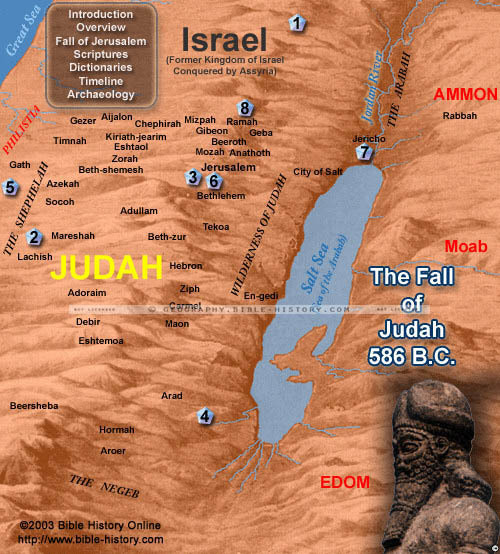
The map of the Fall of Judah in 586 B.C. offers a powerful visual representation of a profoundly significant event in ancient history. This event marked the destruction of the city of Jerusalem, the capital of the Kingdom of Judah, and the subsequent exile of its people to Babylon.
Geographical Context:
This map provides a detailed view of the geographical setting of the Kingdom of Judah, with a particular focus on Jerusalem and its surroundings. It outlines the city's fortifications, walls, and key landmarks.
Siege and Destruction:
The map vividly portrays the stages of the siege of Jerusalem by the Babylonian forces under King Nebuchadnezzar. It highlights the military strategies employed during the siege, including the construction of siege ramps and battering rams.
City of Jerusalem:
The map features the city of Jerusalem as it stood during this critical period, showcasing its gates, the Temple, the royal palace, and the residences of its inhabitants.
Exile and Diaspora:
It may include markers or references to the forced exile of the Judean population to Babylon, marking the beginning of the Babylonian Captivity, a defining event in Jewish history.
Prophetic Messages:
The map can indicate locations associated with the prophetic messages delivered by figures like Jeremiah, who warned of the impending doom and called for repentance.
Religious Significance:
Exploring the map allows viewers to gain insights into the religious significance of Jerusalem and the impact of the Temple's destruction on Jewish faith and practice.
Post-Exilic Period:
The map may include markers showing the eventual return of some exiled Judeans to their homeland and the subsequent rebuilding of Jerusalem and the Temple.
Historical Context:
It provides historical context, shedding light on the political, social, and cultural dynamics of the time, including the influence of Babylonian and Judean leadership.
The map of the Fall of Judah in 586 B.C. allows viewers to immerse themselves in the harrowing events surrounding the destruction of Jerusalem and the Babylonian Captivity. It provides a visual representation of the geography, siege, destruction, and religious and historical significance of this pivotal moment in ancient history, deepening the understanding of the biblical narrative and its impact on the Jewish people.
Blank Topo Map of The World
Abraham’s Journey
The Captivity of Judah (586-516 B.C.)
The Fall of Judah 586 B.C.
The Northern Kingdom of Israel
The Southern Kingdom of Judah
The Divided Kingdom
The Fertile Crescent
Ur of the Chaldees
Shechem in Old Testament Times
Prophets, Kings, and Nations
Jesus Last Passover
New Testament Israel
New Testament Places
Old Testament Israel
Provinces of the Roman Empire
Israel during David’s Kingdom
David’s Kingdom
Cities of the New Testament 4
Cities of the New Testament 3
Cities of the New Testament 2
Mediterranean Sea
Cities of the New Testament
First Century Jerusalem
Empire of David and Solomon
David’s Kingdom
Israel Under Rehoboam
Ophir and Tarshish
The Period of the Kings
Ramoth Gilead
Samaria
Solomon’s Temple
Zarephath and MT Carmel
Jabesh Gilead and Tribes
Judah in the Time of David
Kingdom of Saul
Kirjath Jearim
Michmash
Mount Gilboa in the Time of David
Nob Davids Flight
Shiloh
Israel and Judah
Assyrian Empire Under Esarhaddon
Assyrian Empire Under Sennacherib
Captivity of 10 Tribes
Events in 2 Kings
The Khabur River
Israel and Syria
Captives From Judah
Kingdom of Jeroboam
Mesha’s Kingdom
Pharaoh Necho Battles King Josiah at Megiddo
Babylonian, Mede and Persian Empires
Samaria and Nearby Territories
Syria at its Height
Hebron
Mahanaim
1949 Map of Israel With Boundaries
First & Second Journeys of Paul
Journeys of the Apostles
Paul’s Third Missionary Journey
Saul’s Journey to Damascus and Arabia
Paul’s Final Visits
Paul’s 1st Missionary Journey
Paul’s 2nd Missionary Journey
Paul’s 3rd Missionary Journey
Paul’s Voyage to Rome
Phillip Journeys to Samaria and Gaza
Judah at the Time of Amos
Empire of Alexander the Great
Israel Under the Maccabees
Galilee During Maccabees
Idumea Intertestamental Period
Kingdom of the Ptolemies
Kingdom of the Seleucids
Ptolemaic Egypt Seleucid Asia
The Roman World
Kingdom of Ptolemies and Seleucids
The World During the 6TH Century BC
Mount Horeb
The Red Sea
The Exodus
Ezra’s Journey to Restore Jerusalem
Israel and Judah During Hosea’s Time
The Ancient World
Canaan During the Time of Abraham
The City of Shechem
Supposed Location of the Garden of Eden
The Land of Israel in Genesis
The Jordan River
The Kingdom of Nimrod
Mount Ararat and Mesopotamia
The Descendants
Sodom and Gomorrah
The Kingdom of Egypt
The Hamites
The Kingdom of the Hittites
Ur of the Chaldees
Judah at the Time of Haggai
Jesus Passes Through Samaria
